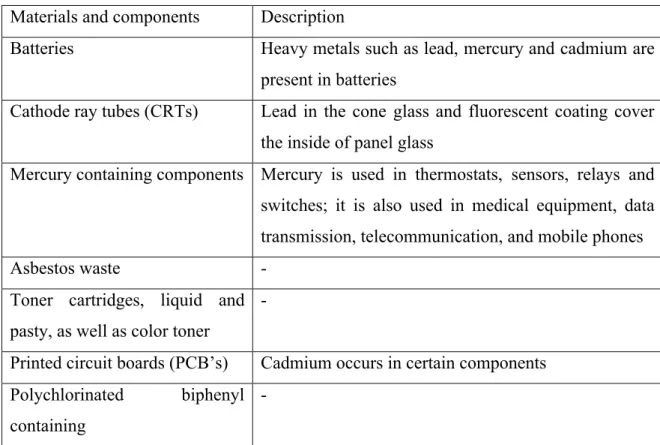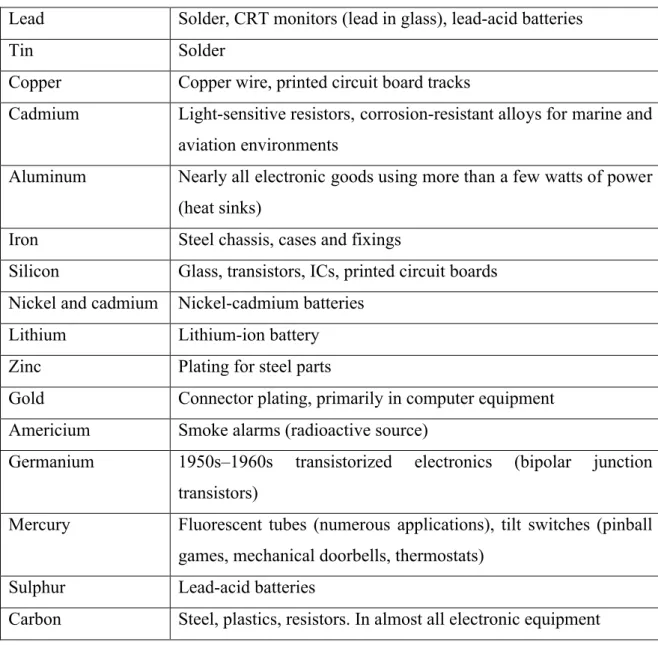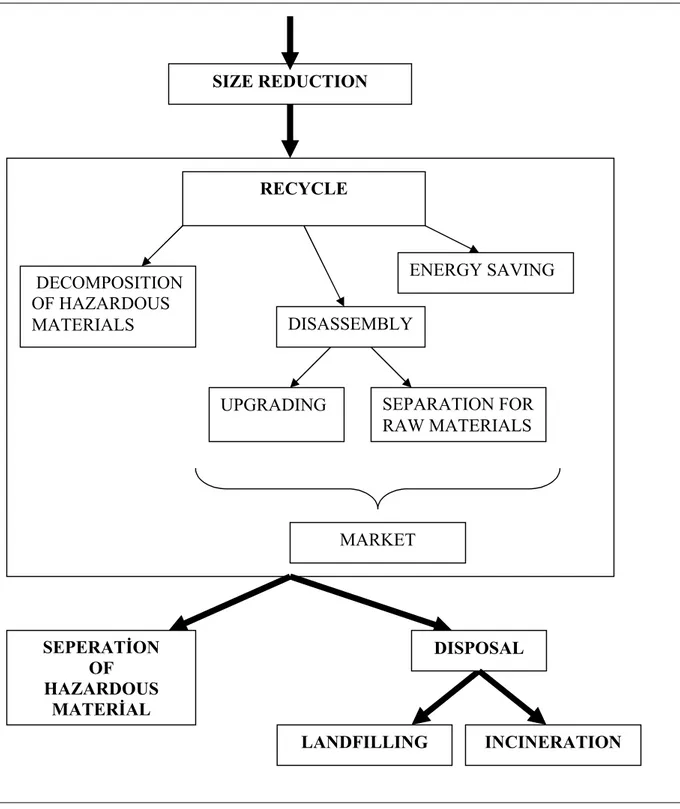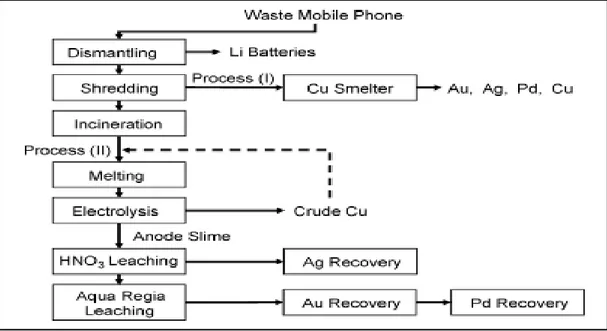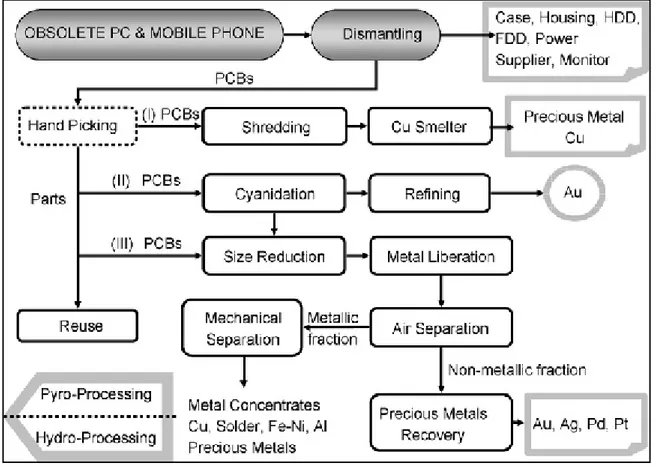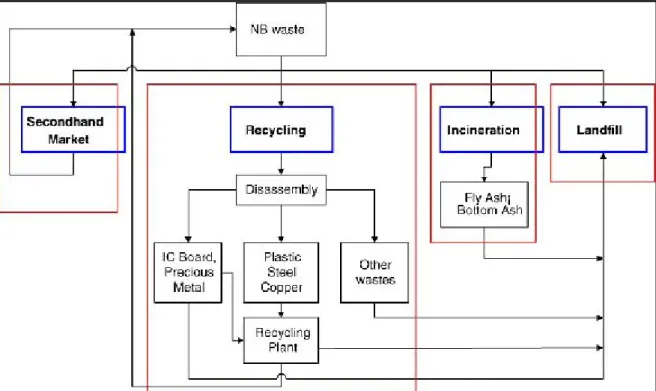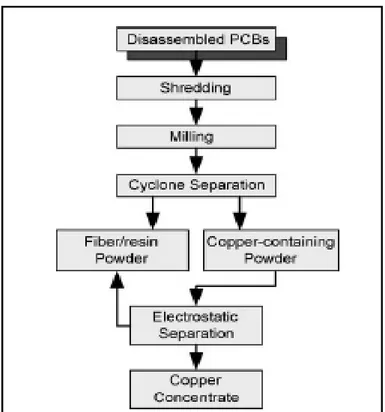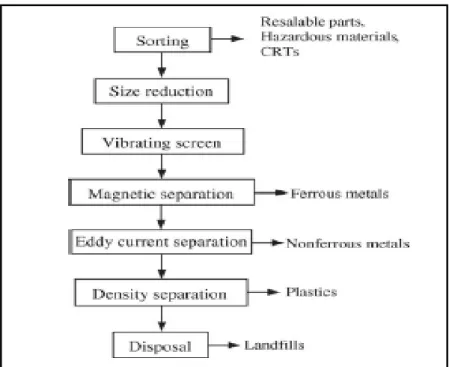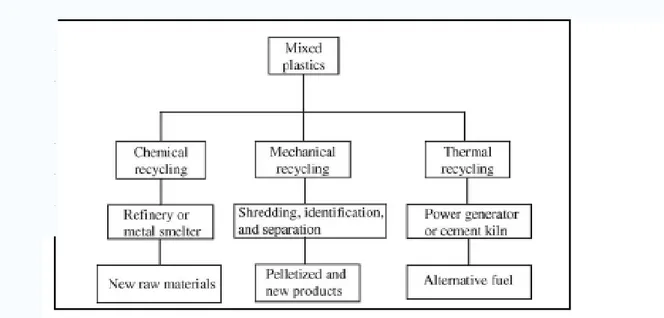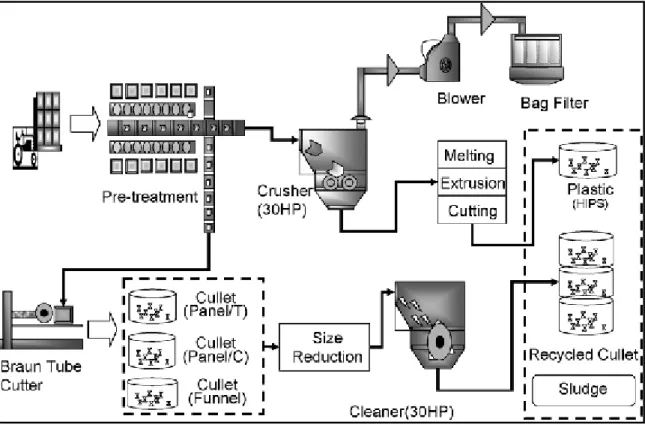T.C.
BAHÇEŞEHİR ÜNİVERİTESİ
THE SELECTION OF THE PROCESS OF WASTE
ELECTRIC AND ELECTRONICAL EQUIPMENT
MANAGEMENT
Graduate Thesis
ÇAĞRI ÖZGÜN
T.C.
BAHÇEŞEHİR ÜNİVERİTESİ
INSTITUE OF SCIENCE
INDUSTRIAL ENGINEERING
THE SELECTION OF THE PROCESS OF WASTE
ELECTRIC AND ELECTRONICAL EQUIPMENT
MANAGEMENT
Graduate Thesis
Çağrı ÖZGÜN
SUPERVISOR: ASISTANT PROF. F. TUNÇ BOZBURA
T.C
BAHÇEŞEHİR ÜNİVERSİTESİ
INSTITUTE OF SCİENCE
INDUSTRIAL ENGINEERING GRADUATE PROGRAM
Name of the thesis: Selection of the process of waste electric and electronical equipment management
Name/Last Name of the Student: Çağrı Özgün Date of Thesis Defense: 07.06.2008
The thesis has been approved by the Institute of Science.
Prof. Dr. EROL SEZER Director
I certify that this thesis meets all the requirements as a thesis for the degree of Master of Science.
Asistant Prof. F. Tunç BOZBURA Program Coordinator
This is to certify that we have read this thesis and that we find it fully adequate in scope, quality and content, as a thesis for the degree of Master of Science.
Examining Comittee Members Signature
Title Name and Surname
Asistant Prof. F. Tunç BOZBURA ---Asistant Prof. Ahmet BEŞKESE ---Asistant Prof. Cengiz KAHRAMAN
---ACKNOWLEDGEMENT
I would like to thank my supervisor, F. Tunç Bozbura, for accepting my proposal of a rather unexpected kind of a project, believing in me to fulfill my task to completion successfully. This project would not be written without the support and trust on my capabilities from Ahmet Beşkese, to whom I am deeply thankful.
I deeply thank Müjde Erol Genevois for the starting idea of the concept of my research, her guidance and continuous encouragement of every kind throughout my education life.
At last, I thank my parents and family for their enduring love, understanding and support throughout my life.
ABSTRACT
SELECTION OF THE PROCESS OF WASTE ELECTRIC AND ELECTRONICAL EQUIPMENT MANAGEMENT
Özgün, Çağrı
Industrial Engineering Graduate Program Supervisor: Yard. Doç. F. Tunç BOZBURA
(06,2008), 104
Being a consumption society; avoiding its responsibilities is the handicap of today’s world. During last decades, according to the mass of human population and its demands, rapid urbanization, technological innovations, shorten product life and market expansion of electrical electronic equipments; a new type of problem challenge the world biologically, physically and socially which define as Waste of Electrical Electronical Equipment. It’s becoming larger quantities of waste stream around the world which threats the human health and poses risks to the environment. To handle these consequences, the process of waste management has to be drawn clearly from the production to the disposal, but the requirements, capabilities and process of management differ relatively to existing methods, status and economy of country.
This paper provides a general overview of WEEE data and management practices employed in the world and Turkey. In Turkey, adequate legal and legislative arrangement, lack of social and governmental responsible and weak capabilities of industry to implement and enforce the waste management create a conflict typical for developing countries and constrain the right and useful application possibilities to manage WEEE as reuse or recycling.
In this paper, WEEE’s data taken from the fabric Oyak Renault is operated with the processes different which are modeled according to reuse and recycling methods and are compared by cooperation of some expertise firms, civic governments and ministry of environment. The target is analyzing the effectiveness in perspective of environmental impact, recovery quantity and economic benefit. The study is realized by two multi criteria decision making practices: one of the multi objective decision making, Fuzzy Goal Programming and one of the multi criteria decision making, Fuzzy AHP focused on the selection of the right model. Thus the comparison of the processes becomes the comparison of two practices. The problems are solved by Lindo and according to the direction of the results the selection of processes and choices are criticized.
According to results, it is observed the proposed models are preferable and effective than existing. Although a proposed, developed model for WEEE management need more investments and provisions; their economic, quantitative, environmental recovery and social impact achieve more advantages over the long terms.
ÖZET
ELEKTRİKLİ VE ELEKTRONİK ATIKLARIN YÖNETİM SÜREÇLERİNİN SEÇİLMESİ
Çağrı Özgün
Endüstri Mühendisliği Yüksek Lisans Programı Tez Danışmanı: Yard. Doç. F. Tunç BOZBURA
(06,2008), 104
Tüketim toplumu olmak ve bunun sorumluluklarını göz ardı etmek; bugün dünyanın karşı karşıya kaldığı handikaplardan biridir. Günümüzde artan insan nüfusu ve ihtiyaçları, hızlı kentleşme, inovasyon, kısalan ürün hayat döngüleri ve elektrik elektronik pazarındaki büyüme bizi yeni bir sorumlulukla tanıştırmıştır: Elektrikli ve elektronik aygıt atıkları (EEAA).
Çevre ve insan sağlığı açısından taşıdığı riskler düşünüldüğünde bu atıkların sonuçlarıyla baş edebilmek için üretiminden bertaraf edilmesine kadar planlanmış etkin bir atık yönetimi düzenlenmeli ve ülkelerin statüleri, ekonomileri, mevcut durumları hesaplanarak bu süreç ve onun ihtiyaçları ve yeterlilikleri tasarlanmalıdır.
Bu çalışmada dünyadaki ve Türkiye’deki EEAA verileri ve yönetimleri hakkında genel bir öngörü oluşturulmuş. Bu bilgiler ışığında Türkiye için olası süreçler tanımlanmış ve uygun bir yönetim modeli kurulmuştur. Oyak Renault Fabrikasından alınan veriler geri dönüşüm ve yeniden kullanma yöntemlerine göre işletilmiş ve ortaya çıkan modeller Doğa Entegre Geri Dönüşüm Endüstri A.Ş. firmasının danışmanlığı ile kıyaslanmıştır. Çalışmanın hedefi çevresel ve ekonomik faydalar ve geri dönüşümü sağlanan ürün miktarı açısından süreçleri değerlendirmek ve seçim yapabilmektir. Çalışma çok kriterli (amaçlı) karar verme yaklaşımlarından geliştirilen iki yöntem kullanılarak gerçekleşmektedir: Çok amaçlı karar verme (Bulanık Hedef Programlama) ve bulanık çok ölçütlü karar verme (Bulanık AHP). Modeller Lindo ile çözümlenmiş ve sonuçlar doğrultusunda süreç seçimleri yorumlanmıştır. Elde edilen sonuçlara göre, uygulamada önerilen model mevcut modellere oranla daha fazla yatırıma ihtiyaç duymasına rağmen çevre ve yeniden kullanım sonuçları ile tercihe edilebilecek etkin bir yöntem olarak görülmüştür. Geri dönüşüm ve yeniden kullanım kavramı ele alındığında uzun dönemlere yayılmış avantajlar ölçüt olarak göz önünde bulundurulmalıdır; böylece üreticiler için yeni bir hammadde kaynağı, tüketiciler için alternatif ürün profili ve sanayi için de daha çevreci bir üretim sahası yaratılabilmektedir.
Anahtar Kelimeler: Elektrikli ve Elektronik Aygıt Atıkları (EEAA), Geri
LIST OF TABLES... vi
LİST OF FİGURES... viii
1. INTRODUCTION...1
2. THE DEFINITION AND PRESENTATION OF E-WASTE ... 4
2.1. WHAT IS E-WASTE………...4
2.2. WASTE MANAGEMENT: HOW CAN WE DEAL WITH E-WASTE ?. 8 2.2.1. Insfrastructure...12
2.2.2. Collection...14
2.2.3. Demanufacturing or Dissasembly...17
2.2.4. Recycling of WEEE...19
2.2.4.1. Mechanical / Physical Recycling... 21
2.2.4.2. Biological Processing... 26
2.2.5. Disposal... 28
2.2.5.1. Land-filling...29
2.2.5.2. Incineration... 29
2.3. THE PERCEPTION OF E-WASTE BY SOCIETES...31
2.3.1.The Concern of the World ...32
2.3.2. EU Directives... 35
2.3.2.1. Waste Electric and Electronical Equipment (WEEE) Directives... 36
2.3.2.2. Restriction of Hazardous Substance Directive...37
2.3.2.3. Similar Directives of RoHS in other regions... 39
2.3.3. The Concern of Turkey...41
3. RESEARCH TECHNIQUES... 51
3.1. DECİSİON MAKING...51
3.1.1. Elements of Multi Criteria Decision Making...52
3.1.2. Classification of Multi Criteria Decision Making... 57
3.1.2.1. Multi-Objective Decision Making, Multi-Attribute Decision Making.. 59
3.1.2.2. Decision Making Under Certainty versus Uncertainty………...……..61
3.2. MCDM TECHNIQUES USED IN THE APPLICATION... 64
3.2.1. Goal Programming and Fuzzy GP Literature Review……….65
3.2.2. The formulations of GP and FGP…...69
3.2.2.1. Goal Programming………... 71
3.2.2.2. Fuzzy Programming………...………...…………. 73
3.2.2.3. Fuzzy Goal Programming... 75
3.2.2.4. The Relationship Between GP and FP... 78
3.2.1. Fuzzy Analytical Hierarchy Process………..……...…….80
3.2.2. Fuzzy Membership Function………...……...86
4. APPLICATION...87
4.2.2. Objectives...91
4.2.3. The Constraints of Model………...……….... 93
4.2.4. Tranformation of Fuzzy Goals………...…….………..94
4.2.3. The Final Form……….……….... 95
4.3. FORMULATION OF AHP MODEL FOR WEEE MANAGEMENT... 97
4.3.1. Formulate the Model for Environmental Problems……...…………97
4.3.2. Prioritize the alternatives………….………... 100
5. CONCLUSION...105
REFERENCES... 107
APPENDİX... 116
LIST OF TABLES
Table 2.1: The contents of EU Legistations 5
Table 2.2: Major hazardous components in waste electric and electronic equipment 6 Table 2.3: List of example applications of the elements and substances 8
Table 2.4: Summary of collection options and transportation responsibilities 15
Table 2.5: Summary of the material types in de-manufactured TV’s and computers 20 Table 2.6: The historical advances of the directives concerning e-waste 40
Table 2.7: Amounts of packaging waste (tons/year) placed in to market,
and estimated recovery and recycling figures for Turkey in 2000 43
Table 2.8: Scope and source of separate collection data
used in this study (operated in cooperation with ÇEVKO and local municipalities) 44
Table 2.9: Cost data for municipal solid waste collection and disposal,
for some selected cities full scope of this survey comprises 24 cities 45
Table 2.10: Cost estimation for a medium sized city wide
recycling program for Turkey, with difficult collection methodology 46
Table 2.11: Sales value of sorted material with different collection source 46
Table 2.12: The legislations published by the ministry of environment 48
Table 2.13: The investments need related to directives of waste management 49
Table 3.1: The historical development of the decision making studies 51
Table 3.2: Examples of these two types of MCDM developed in literature 60
Table 3.2: Linguistic variables of fuzzy membership function 86
Table 4.1: E-waste in OR 91
Table 4.2: Percentage of the recovery types for e-waste 91
Table 4.3: The recovery of e-waste in OR
by sorting type of recovery and their income 92
Table 4.6: The fuzzy criteria weights 102
Table 4.7: The fuzzy performance of all criterias 102
LIST OF FIGURES
Figure 2.1: The steps of waste management’s process 4
Figure 2.2: Schematic of typical components of electronic waste 20
Figure 2.3: Flow sheet for the recycling of metal values
from waste mobile phones 21
Figure 2.4: Strategic processes for the recycling of waste PCBs 22
Figure 2.5: An example of the schematic of disassembly of notebook 23
Figure 2.6: PCB upgrading processing 24
Figure 2.7: Simplified schematic of the process steps
at mechanical/physical recycling 25
Figure 2.8: Recycling option for managing plastics from e-waste 26
Figure 2.9: Simplified flow diagram of waste televisions and
CRT monitors recycling plant 27
Figure 2.10: Simplified flow diagram of waste refrigerators recycling plant 28
Figure 2.11: WEEE recycling system
including steps up to the production of secondary raw material 30
Figure 2.12: WEEE recycling and disposal systems
including production of primary raw materials and incineration. 31
Figure 3.1: Framework for multi criteria decision analysis 54
Figure 3.2: Classification of multi criteria decision problems 58
Figure 3.3: The steps for formulation of a fuzzy AHP model 81
Figure 3.4: Fuzzy membership function 84
Figure 4.1: Triangular membership function 94
Figure 4.2: The hierarchical structure of the waste problems
including all quantitative and qualitative criteria 101
Figure 4.4: The ranking result of e-waste management criterions
1. INTRODUCTION
The balance between production and consumption is critical line whish is have to drawn diligently. However the consumption supported by humankind and influenced by world population take an advantage situation whereas the resources of world exhausting rapidly. The humankind has to show attention to produce, create new values and discover new type of resource similarly to consume. Because the resources of world already limited for the next periods; we have to produce, consume then produce and use again the one consumed. Thus the recovery of used products which could be defined as waste management is becoming the critical. It is the major concern of industrialized and densely populated countries because of the huge amount of waste produced after manufacturing or consumption. (Fleischman,2001)
Product recovery has been considered as a logistic function besides an engineering function; but the direction of process is reverse. The process begins with the collection of products generally from consumers and finished at producers as a raw material or part. The logistics notion includes many activities as return to supplier, remanufacture, and sale at second hand market, recycle, etc.
Because of unsatisfied demand, rapid change in technology, increasing consumption and irresponsible human behaviors (like preference of brand, desire of acquiring the last product in market on the contrary preference of functionality); the diversity of waste is enormous. Paper, glass, household, metal, medical, industrial waste are the some first comers examples. In this study, we observe a specific example of waste: the waste electric and electronical equipment (WEEE).
The world is contending with larger quantities of electronics are coming into the waste stream without attention of societies. Managing the increasing volumes of e-waste effectively and efficiently–in cost and environmental impact–is a complex task. Collecting the e-waste, separating e-waste from its many hazardous substances which are extremely dangerous to human health and the environment and their disposal is evaluating with special logistic requirements and special treatment to prevent the
leakage and dissipation of toxics into the environment. Besides these weakness, being a rich source by recovery create lucrative business in both developed as well as developing countries. While some countries have organized systems for the collection, recycling, disposal and monitoring, other countries are still to find a solution that ensures jobs while minimizing the negative environmental impacts of e-waste recycling. The research expresses the current situation of countries and Turkey briefly.
To perceive the WEEE as a value added services besides its own business sector (EEE) for the manufacturing, information technologies, energy industry and also for national economy and ecology; the management of WEEE have to be a national and civil strategy. All of the level in industry (hierarchical government to secondhand dealers and consumer) is organized considering the benefits to cycle of process.
The research focuses on the strategies of effective management of WEEE, the process of recovery of WEEE and selection of a process of WEEE management whose implementation achieve more higher revenue in different means. In this study; we choose a fabric to realize the process of WEEE management and observe the results according to movements of variables.
As we mentioned that the process contain variables; the management of WEEE include also, some constraints (like limited storage area, cost of investment’s limit, environmental responsibilities, etc.) or some targets as higher revenue, lower damage level of human health of environment or entities as current companies working on recycling, collection, etc. and selection of each of them make the problem complex.
Multi criteria decision making is an approach which is identifying and choosing the best decision under the alternatives depend on values and preference of situation. This approach helps us to find a reasonable solution where the alternatives make the problem environment conflicting. The management of WEEE has to be chosen relatively to the company, government or country’s most preferred targets. Thus the best approximation could be obtained by the help multi criteria decision making.
The methods used in the research are fuzzy goal programming (FGP) and fuzzy Analytical Hierarchy Process (AHP). The common parts of two different methods are that both are operation the approach of multi criteria decision making and both are fuzzy; since the area of study include uncertainty as randomness and risk as non-predictable variables. To handle such problem fuzzy extension of each decision could be helpful.
Both of the methods decide the feasible and better process of WEEE management. Although FGP introduce quantitative result according to information given and has a chance to evaluate the goals simultaneously; Fuzzy AHP introduce linguistic decisions by adding the expertise views to the problem and subsequently evaluate more criteria which couldn’t be expresses quantitatively or by absolute numbers.
In the first part, we profoundly represent the definition, the process and management of WEEE by illustrating the current managements in the world. This part is concluded by the detailed portrait of WEEE system in Turkey. Second part is dedicated to the decision making and we introduce the methods which are realized the problem. The most important part of study is the application which could be the sample minimized of the process of WEEE. We confirm the most preferable type of process which could also be a compound of different types, but we try to minimize the complexity of problem to obtain more understandable results. The sample is the process of e-waste taken from an international automotive fabric, OYAK Renault A.Ş. The expertise used in the fuzzy AHP method and the approximate costs is provided by DOĞA Entegre Limited A.Ş. who is the first licensed recycler in Turkey. The research could be made broader by adding the revenues of product recovered.
In conclusion the study explicate the efficient process which could be the strategy of country to take an advantage in this developing business area, the weakness and strengths of the different processes and make a chance to compare the different multi criteria decision making methods.
2. THE DEFINITION AND THE PRESENTATION OF E-WASTE
Electronic waste (e-waste) or Waste Electrical and Electronical Equipment (WEEE) is a waste type consisting of any broken or unwanted electrical end electronical appliance. It is a point of concern considering that many components such equipment are considered toxic and are not bio-grabble.
E-waste for short - or Waste Electrical and Electronic Equipment (WEEE) - is the term used to describe old, end-of-life or discarded appliances using electricity. It includes computers, consumer electronics, fridges etc which have been disposed of by their original users. While there is no generally accepted definition of e-waste, often it is associated with relatively expensive and essentially durable products used for data processing, telecommunications or entertainment in private households and businesses. But the ever increasing digitalization of products blurs such a distinction from former electrical appliance such as a kettle, a boiler or an oven; all do or will soon contain electronic circuits and ultimately become e-waste.(Carroll, 2008)
2.1 What is E-Waste?
There has been also some conflict about the definition. Some activists define "Electronic waste" to include all secondary computers, entertainment devices electronics, mobile phones and other items, whether they have been sold, donated, or discarded by their original owner. This definition includes used electronics which are destined for reuse, resale, salvage, recycling or disposal. Others define the reusable (working and repairable electronics) and secondary scrap (copper, steel, plastic, etc.) to be "commodities", and reserve the use of the term "waste" for residue or material which was represented as working or repairable but which was discarded by the buyer.
Debate continues over the distinction between "commodity" and "waste" electronics definitions. Some exporters may deliberately leave obsolete or non-working equipment mixed in loads of working equipment (through ignorance, or to avoid more costly
specifically seek to exclude working or repairable equipment in order to protect domestic manufacturing markets. "White box" computers ('off-brand' or 'no name' computers) are often assembled by smaller scale manufacturers utilizing refurbished components. These 'white box' sales accounted for approximately 45% of all computer sales worldwide by 2004, and are considered a threat to some large manufacturers, who therefore seek to classify used computers as 'waste'.
While protectionists may broaden the definition of "waste" electronics, the high value of working and reusable laptops, computers, and components (e.g. RAM), can help pay the cost of transportation for a large number of worthless "commodities". Broken monitors, obsolete circuit boards, short circuited transistors, and other junk are difficult to spot in a container load of used electronics.
Until such time as equipment no longer contains such hazardous substances, the disposal and recycling operations must be undertaken with great care to avoid damaging pollution and workplace hazards, and exports need to be monitored to avoid "toxics along for the ride". [16]The table below show the categories of e-waste used in European Union legislations.(wikipedia, 2008)
Table 2.1: The contents of EU legislations
EU WEEE Directive
Large Household Appliances
Washing machines, Dryers, Refrigerators, Air-conditioners, etc.
Small Household Appliances
Vacuum cleaners, Coffee Machines, Irons, Toasters, etc
Office, Information & Communication Equipment
PCs, Laptops, Mobiles, Telephones, Fax Machines, Copiers, Printers etc.
Entertainment & Consumer Electronics
Televisions, VCR/DVD/CD players, Hi-Fi sets, Radios, etc
Lighting Equipment
Electric and Electronic Tools
Drills, Electric saws, Sewing Machines, Lawn Mowers etc. (Except: large stationary tools/machines)
Toys, Leisure, Sports and Recreational Equipment
Electric train sets, coin slot machines, treadmills etc.
Medical Instruments and Equipment Surveillance and Control Equipment Automatic Issuing Machines
Legend: WEEE Directive implemented by Member States by August 2005 – 08
WEEE is non-homogenous and complex in terms of the materials and components. Many of the materials are highly toxic, such as chlorinated and brominated substances, toxic metals, photoactive and biologically active materials, acids, plastics and plastic additives. Major categories of hazardous materials and components of WEEE are listed in Table 2.2.
Table 2.2: Major hazardous components in waste electric and electronic equipment Materials and components Description
Batteries Heavy metals such as lead, mercury and cadmium are present in batteries
Cathode ray tubes (CRTs) Lead in the cone glass and fluorescent coating cover the inside of panel glass
Mercury containing components Mercury is used in thermostats, sensors, relays and switches; it is also used in medical equipment, data transmission, telecommunication, and mobile phones
Asbestos waste
-Toner cartridges, liquid and pasty, as well as color toner
-Printed circuit boards (PCB’s) Cadmium occurs in certain components Polychlorinated biphenyl
-Capacitors -Liquid crystal displays (LCD’s) -Plastics containing halogenated flame
During incineration/combustion of the plastics
Retardants Halogenated flame retardants can produce toxic components
Equipment containing CRC HCFC or HFC’s
HCFC or CFC’s are present in the foam and the refrigerating circuit
Gas discharge lamps Mercury is present in them
With these hazardous elements, WEEE can cause serious environmental problems during disposal if not properly pretreated. For example, the cadmium from one mobile phone battery is sufficient to pollute 600.000 lt. of water. Growing attention is being given to the impacts of the hazardous components in WEEE on the environment.
Electronic waste is a valuable source for secondary raw materials, if treated properly, however if not treated properly it is a major source of toxins and carcinogens. Technical solutions are available but in most cases a legal framework, a collection system, logistics and other services need to be implemented before a technical solution can be applied. The Association of Plastics Manufactures in Europe released their statistics of material consumption in EEE in Western Europe in 1995. Relatively the composition was as follows: 38% ferrous, 28% non-ferrous, 19% plastics, 4% glass, 1% wood, and 10% others.
In general, printed circuit board (PCB) scrap contains approximately 40% metals, 30% plastics, and 30% ceramics. The typical metal scrap in PCB consists of copper (20%), iron (8%), tin (4%), nickel (2%), lead (2%), zinc (1%), silver (0.2%), gold (0.1%), and palladium (0.005%). Polyethylene, polypropylene, polyesters, polycarbonates and phenol formaldehyde are the typical plastic components. These materials are valuable and could be recycled by proper technologies. Besides, a significant amount of disposed equipment might be collected for reuse or remanufacturing. (Wenzhi et al. 2006)
Table 2.3: List of example applications of the elements and substances
Lead Solder, CRT monitors (lead in glass), lead-acid batteries
Tin Solder
Copper Copper wire, printed circuit board tracks
Cadmium Light-sensitive resistors, corrosion-resistant alloys for marine and aviation environments
Aluminum Nearly all electronic goods using more than a few watts of power (heat sinks)
Iron Steel chassis, cases and fixings
Silicon Glass, transistors, ICs, printed circuit boards Nickel and cadmium Nickel-cadmium batteries
Lithium Lithium-ion battery
Zinc Plating for steel parts
Gold Connector plating, primarily in computer equipment Americium Smoke alarms (radioactive source)
Germanium 1950s–1960s transistorized electronics (bipolar junction transistors)
Mercury Fluorescent tubes (numerous applications), tilt switches (pinball games, mechanical doorbells, thermostats)
Sulphur Lead-acid batteries
Carbon Steel, plastics, resistors. In almost all electronic equipment
2.2 Waste Management: How Can We Deal With E-Waste?
We identified the components and the hazardous substances of this type of waste; but none of consumers or producers aren’t enough aware of these information. Consumers and producers have focused on new properties, technologies, brands and innovation of equipment. They haven’t realized the consequences yet: Environmental impact, Health care perspective, social impact internationally, capacities of the factor terrestrial.
According to Cui and Forssberg (2003), the production of electronic and electrical equipment (EEE) is one of the fastest growing areas. In the meantime, both technological innovation and market expansion of EEE are accelerating the replacement of outdated EEE, leading to a significant increase in waste of EEE (WEEE) that induces a new environmental challenge.
In West Europe, 6 million tones of WEEE were generated in 1998, and the amount of WEEE was expected to increase by at least 3–5% per annum (Poonam, Arvind 2007). In the USA, it was said that over 315 million computers would reach their date of expiration by 2004 (Kang, Schoenung 2005). In Australia, there are approximately 9 million computers, 5 million printers and 2 million scanners currently in households and businesses, and all of them will be replaced, most within the next couple of years. (Wenzhi et al. 2006)
From past records, it seems certain that new problems of physical, biological and social change, not now widely anticipated, will arise sooner than later. This is because our scientific knowledge of each of these systems is incomplete, the mass of human population and its demands are increasing relentlessly and the possible human adjustments and adaptations, including technology, are multiplying (White, 1996). Only a few years ago, some of the environmental issues of concern included the trio: acid rain, stratospheric ozone layer depletion and global warming.
Today, waste electrical and electronic equipment (WEEE) or electronic waste (e-waste) generation, trans-boundary movement and disposal are becoming issues of concern to solid waste management professionals, environmentalists, international agencies and governments around the world (Musson et al., 2000; Cui and Forssberg, 2003).
The useful life of consumer electronic products is relatively short, and decreasing as a result of rapid changes in equipment features and capabilities (Kang and Schoenung, 2004). This creates a large waste stream of obsolete electronic equipment. Due to their hazardous material contents, WEEE may cause environmental problems during the waste management phase if it is not properly pre-treated. As a result, many countries have drafted
legislation to improve the reuse, recycling and other forms of recovery of such wastes in order to reduce disposal (Nnorom,Osibanjo 2007).
Electronic waste recycling is gaining currency around the world as larger quantities of electronics are coming into the waste stream. Managing the increasing volumes of e-waste effectively and efficiently–in cost and environmental impact–is a complex task. Firstly, special logistic requirements are necessary for collecting the e-waste.
Secondly, e-waste contains many hazardous substances which are extremely dangerous to human health and the environment, and therefore disposal requires special treatment to prevent the leakage and dissipation of toxics into the environment.
At the same time, it is a rich source of metals such as gold, silver and copper, which can be recovered and brought back into the production cycle. This particular characteristic of e-waste has made e-e-waste recycling a lucrative business in both developed as well as developing countries. While some countries have organized systems for the collection, recycling, disposal and monitoring, other countries are still to find a solution that ensures jobs while minimizing the negative environmental impacts of e-waste recycling.
To perceive the WEEE as a source of raw materials and energy or as a products of recycling to reuse and resale or as a value added services besides its own business sector (EEE) for the manufacturing, information technologies, energy industry and also for national economy and ecology; the management of WEEE have to be a national and civil strategy. All of the level in industry (hierarchical government to secondhand dealers and consumer) is organized considering the benefits to cycle of process.
Consequently the process of waste management has to be drawn clearly. It’s obvious that the requirements are differing according to status of countries ( developing countries, developed countries, third world countries) , and status of existing methods for waste management ( landfilling areas , collectors , recyclers in competition ,etc. ).
SECONDHAND SECTOR REFURBISHMENT MAINTENCE/RESALE REUSE DEMANUFACTURING REMANUFACTURING COLLECTION TESTING FOR RESALE/REUSE PRODUCTS Public recognition Advertisement Construction of
organizational structure and missions for government Site for landfilling
Companies for treatments and recovery technologies
Legal arrangements Regulations for businesses
Figure 2.1: The steps of waste management’s process
2.2.1 Infrastructure
Public Recognition & Advertisement: With the development of electronic technologies,
SIZE REDUCTION DECOMPOSITION OF HAZARDOUS MATERIALS RECYCLE UPGRADING ENERGY SAVING MARKET SEPARATION FOR RAW MATERIALS DISASSEMBLY SEPERATİON OF HAZARDOUS MATERİAL DISPOSAL INCINERATION LANDFILLING
of parts and the machine resale value drop rapidly with the age of the machines. For example, a computer’s value approaches zero for machines with technologies more than two generations old. Furthermore, old equipment is more difficult to recycle than newer equipment. Because electronic recycling is in its infancy, consumer recognition of the need for recycling is a critical factor to the further expansion of this industry. Many consumers do not recycle their electronic products when they first become defunct or obsolete. Consequently the government has to make public conscious of the waste management programs. Effective electronics recycling requires that consumers both have access to recycling programs and have knowledge of such programs. This essentially means that consumers need to know where to take their electronic devices when they become obsolete or defunct (Kang, Schoenung 2004)
Legal Arrangement & Regulation for Companies: There have been some examples in the developed countries such as ARF (advanced recycle fees) and EPR (extended producers responsibilities) which is encouraged the businesses to join the cycle of waste management program. Also the arrangement state strictly the content of the hazardous substances and the equipments in which is containing them to inform producers. Regulations must control the production of EEE in industry and the level of capacities at the site of collection and land-filling.
For developing countries the process of waste recycling could become illegal as unregistered workers, child workers, unhealthy conditions, unrecorded income. Thus the directives construct a comprehensive, expanded and successful organization.
Site for Landfilling & Companies for Treatment and Recovery: One of the most important strategic decisions for any company is the location decision, since it affects long-term profits and costs. Changing a location decision is a very difficult and expensive process (Heizer and Render, 2001). Different models study the location decision problem using different location criteria. Models that first solved the location problem were based on quantitative criteria only, aiming at minimizing fixed costs and transportation costs between the production company and its clients. These models have become more complex and have been extended to companies with several products, or to networks of companies.
Additionally, uncertainties have been explicitly taken into account. Nevertheless, they do not consider non-monetary criteria (Queiruga et al. 2006).
Therefore, the numbers of applications of multi-criteria methods, which are able to take into account many objectives and quantitative as well as qualitative variables, has been increasing over the last few years. Using these methods, relevant criteria like quality and density of transportation and telecommunication networks, preferences of the entrepreneur, environmental influences, availability and quality of human capital, quality of life, provision of public services, and participation of the community can be considered.
Construction of Organizational Structure and Missions for Government: All of the waste program organization is related to government arrangements. The head of hierarchy is the government. The authority assigns the tasks to the departments or companies and controls their operations. Moreover it has to meet the requirements of the operations like land-filling areas, incineration plants, and experts on WEEE. There is some suggestion for government as following:
1. Ensure an effective system for monitoring of shipments, appropriate labeling and certification of the functionality of secondhand appliances
2. Implement economic policies such as ARF on new/second hand electrical electronic goods
3. Introduce value-added recovery (refurbishing and remanufacturing), material recovery (formal recycling technology) and energy recovery from the incineration of waste plastics. 4. Create a market of recovered components and modules
5. Assist with technology and funding for the formal recycling of e-waste and the disposal of hazardous components using appropriate disposal technology (Nnorom, Osibaji 2007).
2.2.2 Collection
The collection and transportation step is often the most costly step toward the reuse and recycling of electronic devices (Lonn and Stuart, 2002; IAER, 2003). It has been estimated that collection and transportation costs represent more than 80% of the total cost of
recycling (Hainault and Smith, 2000). Table 2.4 shows a summary of collection options and transportation responsibilities.
T ab le 2 .4 : S um m ar y of c ol le ct io n op ti on s an d tr an sp or ta ti on r es po ns ib il it ie s D is ad va nt ag es P ot en ti al th ef t a nd a ba nd on m en t, N ee d ex tr a so rt in g, H ig h tr an sp or ta ti on c os t Ir re gu la r co ll ec ti on a m ou nt N ee d st or ag e sp ac e N ee d re gu la r ch ec ki ng , N ot ef fe ct iv e fo r al l c om m un it ie s H ig h sh ip m en t c os t, N ee d sp ec ia l p ac ka gi ng , C on su m er s vi si t s hi pp in g lo ca ti on R et ai le r co m m it m en t, N ee d st or ag e sp ac e A dv an ta ge s C on ve ni en t, R es id en t pa rt ic ip at io n In cr ea se r ec yc li ng aw ar en es s, G oo d fo r ru ra l a re a H ig h so rt in g ra te , L ow tr an sp or ta ti on c os t. M os t c os t-ef fe ct iv e N o co ll ec ti on s it e ne ed ed L ow c os t, H ig h vi si bi li ty if p ro m ot ed b y re ta il er R es po ns ib le f or tr an sp or ta ti on T o re cy cl in g si te L oc al g ov er nm en t o r re cy cl er L oc al g ov er nm en t o r re cy cl er L oc al g ov er nm en t o r re cy cl er O E M s or r ec yc le r co nt ra ct w it h O E M s R et ai le r T o co ll ec ti on s it e - Con su m er C on su m er - Con su m er C ol le ct io n op ti on s C ur b si de S pe ci al d ro p-of f ev en t P er m an en t d ro p-of f T ak e-ba ck P oi nt -o f-pu rc ha se
Curbside collection consists of the collection of e-waste either on a periodic basis like a general municipal waste collection or by request. Co-existence of the e-waste collection with an existing curbside waste collection program can substantially reduce the operating costs. This collection model is the most convenient for residents. However, operating costs can be higher than for other collection options.
A special drop-off event is a 1 or 2 day event that is usually held over a weekend to maximize resident participation. In this collection option, the quantity of devices collected will depend on the extent of participation by consumers and the weather during the special event period. A special drop-off event is considered to be an ideal recycling program when experts from the repair industry work together with the program, because these experts can sort out the most valuable items for resale, repair, and reuse.
A permanent collection option is essentially a year-round collection event. The municipal solid waste collection site can be used for collection of e-waste, which results in negligible costs.
This type of program has been found to be the most cost-effective (IAER, 2003), however, this type of collection program is not desirable for every community size. This collection option requires that the quantity of collected devices be checked regularly and that the devices be transported to a recycler when certain quantities are collected.
In the point-of-purchase collection model, retailers of electronic products serve as the collection agency and consumers can bring old electronic equipment to a retailer when they purchase new electronic equipment. The active participation of the retailer is essential for this method of collection to be successful. Several original equipment manufacturers (OEM’s) have established ‘take-back’ collection systems for collecting used electronic products from consumers. IBM, Dell, HP, and other computer manufacturers collect unwanted computer and related products regardless of the original manufacturer (Environmental and Plastics Industry Council, 2003) (Kang, Schoenung 2005).
2.2.3 De-manufacturing or Disassembly
Once the e- waste is collected, electronic waste is tested and sorted; because of the decision on strategies which is treated for reuse, repaired for resale or recycled. This step is the most critical in electronic waste management. The responsible have to classifier the wastes according to their circumstance of usage, their reason causing to become obsolete, their term of life, their components and whether they contain hazardous material. These acquirements guide the expert to choose the most appropriate strategy and process which e-waste will follow.
Collected equipment can be classified in a simple sense as reusable and recyclable. Thus target of reusable e-waste could be in
Refurbishment system for secondary user or second hand market by repair or by detach malfunction part and add new part
Remanufacturing system for secondary users and second hand market by adapting new properties or in new product as a specific part
Component recovery system for same users as well by separating theirs parts as different usage options
In view of this perspective, the environmental problems and high residual value of WEEE, WEEE management system should be established to extend the life cycle of EEE. This management system comprises collection, classification, pre-treatment, etc., and five conventional end-of-life treatment strategies. In accordance with the potential economic and environmental efficiency, these strategies can be categorized as follows:
1. Reuse: the recovery and trade of used products or their components as originally designed;
2. Servicing: a strategy aimed at extending the usage stage of a product by repair or maintenance;
3. Remanufacturing: the process of removing specific parts of the waste product for further reuse in new products;
4. Recycling (with or without disassembly): including the treatment, recovery, and reprocessing of materials contained in the used products or components in order to replace the virgin materials in the production of new goods;
5. Disposal: the processes of incineration (with or without energy recovery) or landfill (Wenzhi et al. 2006)
Naturally the treatment of this step needs a specialized knowledge and experience. The economical value and demand is directly connected to success of these treatments. Also there are lots of researches about disassembly process like robotics. Still at successful and accurate conditions the parts ejected or products repaired wouldn’t be preferred. The reason of preference would be cheap price, however these treatments end specialization increase the price and the substitute new product’s price decrease in today economy and market conditions.
We mention that this step is based on the decision where the e-waste could be used and which strategy could be applied to extend its life cycle. Electronic products, like cars, are a combination of some valuable subcomponents and assemblies – such as the central microprocessor or hard drive – and those that have value only as materials, such as the printed circuit board or housing. The recovery options that are pursued must balance the costs of testing and disassembly, which tend to be labor intensive, with the incremental value of the components over their material value. The technological life cycle of a product has a profound interaction with this decision. For example, CRT’s are a mature product for personal computers and have experienced rapid declines in prices in order to compete with liquid crystal displays (LCD’s) that are penetrating the market. The resale value of recovered CRT’s is, therefore, very low in their original markets. This discourages the testing and refurbishment of CRT’s and increases the need to recover the leaded glass, metals, and plastics. However, as the market for CRT’s declines, leaded glass itself will become obsolete and we will be faced with a disposal problem at a different level.
This problem is more complex for the computer itself, as whole systems, or subsystems can be reused and the obsolescence rate for chips and fixed drives has slowed, but prices
disassembly, and bulk recycling technologies scale in cost very differently with throughput. Thus, for small scale operations that have been adopted to deal with the historical flows of electronic products, disassembly has been possible, but as the volumes, variability, and age of systems increase, there will be a need to shift toward higher throughput, less manually intensive operations (Realff et al. 2004).
2.2.4 Recycling of WEEE
First we have to give a basic definition for recycling. As we mentioned before; Recycling is including the treatment, recovery, and reprocessing of materials contained in the used products or components in order to replace the virgin materials in the production of new goods. Recycling is significant step of the strategies for WEEE management; since the target quantity of waste is highest than the other steps. This means that the income of this step is higher.
First; the step begins with the separation of the hazardous substances. In the previous step, the de-manufacturing, the parts or units in the e-waste is saved for reuse or resale. Thus working systems, valuable components, and hazardous materials are removed from the e-waste, the materials recovery process begins. The primary goal of this process is to separate different types of materials that can be recovered and sold.
Prototypical examples of separation process are shown in figure 2.2 that the majority of the items collected consist of TVs, computers and monitors, and other appliances: Metals (49 wt. %), plastics (33 wt. %), and CRTs (12 wt. %) account for over 90 wt. % of collected e-waste (USEPA, 1999). According to research for residential electronic e-waste collection program in the U.S. when only computers are collected, the distribution is different: glass (25 wt. %), metals (48 wt. %), and plastics (23 wt. %) (Silicon Valley Toxics Coalition, 2004). When only TVs are considered, the distribution is glass (48 wt. %), plastic (15 wt. %), and metal (32 wt. %) (Materials for the Future Foundation, 1999b),(Khetriwal et al. 2005).
33%
12% 1%
49%
5%
plastic glass others metal wood
Table 2.5 shows a summary of the material types in de-manufactured TVs and computers. These results show that the major materials in electronic equipment are metals, plastics and glass.
Fig. 2.2: Schematic of typical components of electronic waste
Table 2.5 : Summary of the material types in de-manufactured TV’s and computers
Materials TV Computer
Glass 47.6 24.8
Plastic 14.7 23.0
Printed wiring board 5.6
-Precious metals 27.1 0.02 Iron - 20.47 Lead - 6.3 Aluminum - 14.17 Copper 4.8 6.93 Others - 4.3 Total 100 100
With the help of recycling technologies; WEEE become a source of raw materials and energy. To recover valuable materials from WEEE, the feed material initially needs to be liberated by mechanical processing so that the desirable fractions can be separated. Hammer mills and shredders are the most commonly used communication devices to reduce WEEE to finer fractions, thus, liberating the phases. Typical methods used to
current separation and air table sorting. (Scheafer et al., 2003) reported that these techniques have shown limited efficiency due to enormous loss of materials (Scheafer et al., 2003). For example, an eddy current separator would separate non-ferrous metals. However, other metals can also be influenced by the magnetic field and affect the purity of the end product. Since there is strict specification for the reuse and recycling of the materials, efficient sorting is of great importance (Bledzki et al., 2002), (Mohabuth, Miles 2004)
En general, the recycling could be composed of four parts: Mechanical/Physical Recycling, Chemical Processing, Thermal Processing and Biological Processing. The most appropriate and significant of them are mechanical and biological recycling.
2.2.4.1 Mechanical/Physical Recycling
The "mechanical" element is usually an automated mechanical sorting stage. This either removes recyclable elements from a mixed waste stream (such as metals, plastics, glass and paper) or processes them. It typically involves factory style conveyors, industrial magnets, eddy current separators, trammels, shredders and other tailor made systems, or the sorting is made by hand. (wikipedia 2008)
With the steadily decreasing of the precious metal contents in EEE, the precious metal-oriented recovery techniques, such as hydrometallurgy and pyrometallurgy, are facing great challenges. On the other hand, mechanical/physical recycling of WEEE, due to its better environmental property and easier operability, is drawing more attention. Compared with hydrometallurgy and pyrometallurgy, mechanical/physical processes can achieve full material recovery including plastics.
Fig. 2.4: Strategic processes for the recycling of waste PCBs
Mechanical recycling of WEEE can be broadly divided into three major stages.
Disassembly (dismantling): targeting on singling out hazardous or valuable components.
Upgrading: using mechanical/physical processing to upgrade desirable materials content, i.e. preparing materials for refining process
Refining: in the last stage, recovered materials return to their life cycle. Disassembly and upgrading are two key processes of the mechanical recycling of WEEE.
Disassembly: Disassembly is a systematic process that removes a component or a part, or a group of parts or a subassembly from a product (i.e., partial disassembly); or splits a product into all of its parts (i.e., complete disassembly) for a given purpose. In WEEE recycling practice, selective disassembly (dismantling) is an indispensable process, since (1) the reuse of components is of the first priority, (2) dismantling the hazardous components is essential, and (3) it is important to dismantle highly valuable components and high grade materials such as PCBs, cables, and engineering plastics in order to simplify the subsequent recovery of materials (Wenzhi et al. 2006).
Fig. 2.5: An example of the schematic of disassembly of notebook
The implementation of disassembly needs highly efficient and flexible tools. The most attractive research on disassembly process is the use of robots. Unfortunately, full (semi) application of automation disassembly for recycling of EEE is full of frustration. Currently, there are only a few pilot projects for automated disassembly of keyboards, monitors and PCBs, and there is no (semi-) automated solution for the personal computer (PC) itself.
The manual disassembly aided by tools, due to its high flexibility, is currently the main dismantling process. A variety of tools are involved in the dismantling process for removing hazardous components and recovery of reusable or valuable components and materials. The disassembled cables, PCBs and metal/plastics mixture, being a mixture of various materials, should be further treated to upgrade the materials contents of them.
Upgrading: WEEE can be regarded as a resource of metals, such as copper, aluminum and gold, and non-metals. Effective separation of them, based on the differences in their physical characteristics, is another crucial process for recycling of WEEE. The upgrading usually includes two stages: comminuting and separating (Wenzhi et al. 2006).
Fig. 2.6: PCB upgrading processing
Comminuting is the first step of the physical upgrading process. Only when the disassembled WEEE is shredded to a proper granularity, can the materials of the WEEE be liberated one another, and then be separated effectively. Basically, the materials present in EEE are attached by fastening, inserting, welding, binding, wrapping and so forth. Therefore, it does not need much intensive energy to unlock the associated materials like
ceramics, glass, and metals having distinctive mechanical properties. The optimized comminuting result is that every comminuted particle is made by sole material.
After liberation of the materials in the disassembled WEEE through comminuting, the separation of them can then be performed by mechanical/physical methods. The differences on the physical characteristics of materials in non-homogeneous compounds, such as magnetism, electric conductivity and density, etc., are the bases of the mechanical/physical separation of them.
Mechanical/physical separation processes include electronic magnetic separation, electronic-conductivity-based separation, density-based separation and so forth. All of them have application instances in the WEEE recycling field. Magnetic separation is widely used for the recovery of ferromagnetic metals from non-ferrous metals and other nonmagnetic wastes. Over the past decade, the advances in the design and operation of high-intensity magnetic separators also make it possible to separate copper alloys from the waste matrix (Kang and Schoenung 2005).Electric conductivity-based separation is used to separate materials of different electric conductivity (or resistivity). There are three typical electric conductivity-based separation techniques: (1) eddy current separation, (2) corona electrostatic separation, and (3) tribo-electric separation.
With the marked density difference between metals and nonmetals in WEEE powders, the heavier metal materials can be effectively separated from non-metal materials by the density based separation methods. In the practice of recycling WEEE, according to the requirements of the task, some of the above methods can be combined together to fulfill the separation of the materials present in WEEE (Kang and Schoenung 2005).
2.2.4.2 Biological Processing
The "biological" element refers to either: Anaerobic digestion , Composting , Bio-drying. Anaerobic digestion breaks down the biodegradable component of the waste to produce biogas and soil improver. The biogas can be used to generate electricity and heat. Biological can also refer to a composting stage. Here the organic component is treated with aerobic microorganisms. They break down the waste into carbon dioxide and compost. There is no green energy produced by systems employing only composting treatment for the biodegradable waste.
Fig. 2.8: Recycling option for managing plastics from e-waste
In the case of bio-drying, the waste material undergoes a period of rapid heating through the action of aerobic microbes. During this partial composting stage the heat generated by
produce a refuse-derived fuel where a dry, light material is advantageous for later transport combustion. Products of this system could be recyclable materials such as metals, paper, plastics, glass etc.; unusable materials prepared for their harmless final deposit; carbon credits; high calorific fraction. The advantages of this type of process are that:
The finally deposited waste is inert
Reduction of the waste volume to be deposited to at least a half (density > 1.3 t/m³), thus the lifetime of the landfill is at least twice as long as usually
Utilization of the leachate in the process
No additional facilities for the collection and combustion of biogas as there is no biogas
Daily covering not necessary, aftercare 3 to 5 years (wikipedia 2008)
The following figures are the examples of the complete process diagram for recycling technologies.
Fig. 2.10: Simplified flow diagram of waste refrigerators recycling plant
2.2.5. Disposal
Disposal is the discharge, deposit, injection, dumping, spilling, leaking, or placing of any solid waste or hazardous waste into or on any land or water, so that such solid waste or any constituent thereof may not enter the environment. That means that the final placement or destruction of toxic, radioactive, or other wastes; surplus or banned pesticides or other
chemicals; polluted soils; and drums containing hazardous materials from removal actions or accidental releases. Disposal includes land-filling and incineration.
2.2.5.1 Land-filling
Disposing of waste in a landfill involves burying waste to dispose of it, and this remains a common practice in most countries. Historically, landfills were often established in disused quarries, mining voids or borrow pits. A properly-designed and well-managed landfill can be a hygienic and relatively inexpensive method of disposing of waste materials. Older, poorly-designed or poorly-managed landfills can create a number of adverse environmental impacts such as wind-blown litter, attraction of vermin, and generation of liquid leachate. Another common byproduct of landfills is gas (mostly composed of methane and carbon dioxide), which is produced as organic waste breaks down anaerobically. This gas can create odor problems, kill surface vegetation, and is a greenhouse gas.
Design characteristics of a modern landfill include methods to contain leachate such as clay or plastic lining material. Deposited waste is normally compacted to increase its density and stability, and covered to prevent attracting vermin (such as mice or rats). Many landfills also have landfill gas extraction systems installed to extract the landfill gas. Gas is pumped out of the landfill using perforated pipes and flared off or burnt in a gas engine to generate electricity (wikipedia 2008).
2.2.5.2 Incineration
Incineration is a disposal method that involves combustion of waste material. Incineration and other high temperature waste treatment systems are sometimes described as "thermal treatment". Incinerators convert waste materials into heat, gas, steam, and ash.
Incineration is carried out both on a small scale by individuals and on a large scale by industry. It is used to dispose of solid, liquid and gaseous waste. It is recognized as a practical method of disposing of certain hazardous waste materials (such as biological medical waste). Incineration is a controversial method of waste disposal due to issues such
as emission of gaseous pollutants. Incineration is common in countries such as Japan where land is scarcer, as these facilities generally do not require as much area as landfills.
Waste-to-energy (WtE) or energy-from-waste (EfW) is broad terms for facilities that burn waste in a furnace or boiler to generate heat, steam and/or electricity. Modern combustion technologies maintain the advantages of incineration without its numerous disadvantages, while providing a clean energy source. Installation of a "boiler" such as the RCBC (rotary cascading bed combustor) allows the consumption of problem waste as fuels for the generation of electricity. Municipal solid waste, sewage, sludge, "dirty coals", and coal byproducts, are cleanly and efficiently consumed for energy production with emissions well within strict regulatory standards. The fly ash byproduct is inert, and can be mixed with compost(wikipedia 2008).
Through this section, we can create a modeling about recycling process of e-waste. We can find out the options which would be possible to recycle the electronic waste. Following figures show us the boundaries of a modeled WEEE recycling system and its disposal.
Fig. 2.11: WEEE recycling system including steps up to the production of secondary raw material
Fig. 2.12: WEEE recycling and disposal systems including production of primary raw materials and incineration.
2.3 The Perception of E-Waste by Societies
From the beginning of 1980’s until today; with help of the induction of consumer oriented technologies, the electrical and electronic industry show an impulse trend economically, renovating and in sense of production unit.
The success of the industry have been creating a developing mass consumer market especially for computers, mobile phones and other personal or entertainment electronic equipment. World must find now ways for safely and economically recovering the materials that are embedded in these products. Furthermore, world is facing an ever growing stream of electronics waste as a result both of the rapidly increasing number of new applications for electronics and of the accelerating pace of technological development and ever shorter service and product life; thus world have to solve the capacity and health problems whose are the results of this consumption.
Through the time passed, some try to compensate the possible damage and threats and to bear responsibility against this mankind’s impact. Nevertheless some try to bury theirs head in the sand in spite of the world’s reactions. Legislations, directives, common contracts and civil organization were established and are advancing globally.
Certainly the first applications were enounced in Europe. European society requests global arrangements among the developed countries initially. Therefore Europeen Union implements the requirements of being responsible and exquisite and widely develops the system of waste management. The far eastern countries as Japan, China, Taiwan and Korea, according to their industrial progress and territory capacities had kept up with the technologies of waste management. But China and Taiwan are carrying the similar troubles with Asian and African countries which they are considered as developing countries or third world countries. They became the trash of other producer countries and themselves. Most of them aren’t aware of the management of waste; at least officially. Even tough the citizens could join the process of the e-waste management accepting all harmful risks. For example it is normal to find an Indian man heating circuit boards over flame to extract metal or to meet a Pakistani child who is ripping out the metal parts of a mouse. Finally America is the most insensitive country against its own society and the world. In spite of its mass production and spreading marketing around the world, the cautions were taken, applied by state decisions and current at that state.
Through that duration; consumer products such as white goods (refrigerator, TV, washing machines, etc.) became similar and simplified to handle their results and recycle. On the contrary; brown goods (especially personal computer) which show rapid growth over the last decade become new challenging category to solve and make them beneficial.
In this section we present the situation of the world and comparatively Turkey.
2.3.1 The concern of the World
The advent of electrical and electronic equipment (EEE) with new functions and design time to time, stimulate consumers’ purchasing desire towards the latest equipments. This leads the rapid increase in the sales of new facilitated models of EEE in the world (LaCoursiere, 2005). Due to the rapid replacement of old model by latest advanced model time to time causes short average lifespan of EEE and consequently leads to yield mass
tremendous amount of bulky WEEE containing variety of hazardous substances is a major social problem and threat to the environment (Brodersen et al., 1992; Lee, 2005).
It is estimated that, by 2005, one computer will become obsolete for every new one put on the market. Between 1997 and 2004, 315 million computers will become obsolete. This will result in the discard of 550 x 106 kg of Pb, 900000 kg of Cd, 180000 kg of Hg, and 0.5 x 106 kg of Cr VI. This will also yield additional waste in the form of 1800 x 106 kg of plastic and at least 159 x 106 kg of brominated flame-retardants from monitors. The disposal of consumer electronics accounts for 40% of Pb in landfills. Additionally, 22% of the yearly world consumption of Hg is used in electronics. The successful capture and reuse of these streams of materials will require a combination of government initiatives at local, regional, national, and supranational levels, as well as public willingness and innovations in materials, products, and recycling technologies. Above all, this is a systems problem, where innovations at different scales and levels must be tied together to achieve the maximum impact (Realff et al. 2004).
For example, several million tonnes of WEEE are being generated in the U.S., EU and Japan (Kang and Schoenung, 2005; Beck, 2004; Clean Japan Center, 2002). In 2001, the quantity of electronic wastes generated in the U.S. was estimated around 2.26 million tonnes and these were mainly: (1) video products such as TVs, VCR decks, camcorders and TV/VCR combinations, (2) audio products including compact disk players, rack audio system and compact audio system, and (3) information products like PC, computer monitors, telephones and fax machines.
In the case of EU, total electronic waste generation was found 5 million tonnes, simultaneously the average quantity of the generation of electronic wastes was observed 14 kg per person in the year 2004 (Beck, 2004). Despite of an enormous amount of WEEE is being generated every year in the U.S. and EU; their treatments are simply relying on incineration or landfill. In the EU, when the WEEE directives are successfully enforced, they can make much contribution towards the constitution of resources-recirculation society that will satisfy both the protection of environment and the conservation of resources (Europa, 2006; Fauve-Buresi, 2006).
